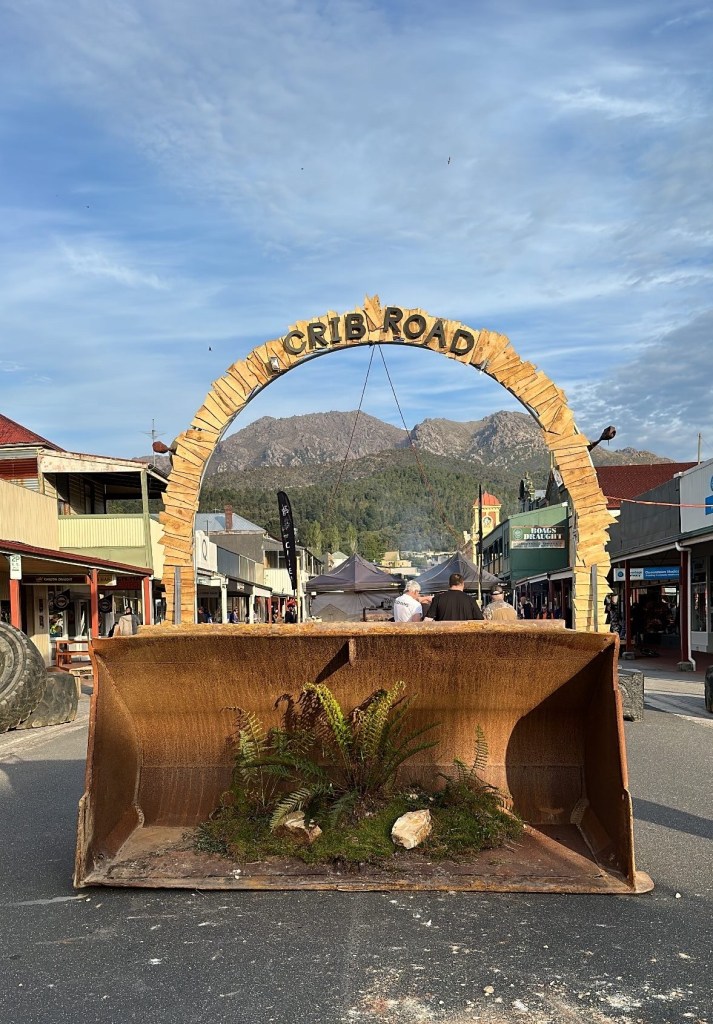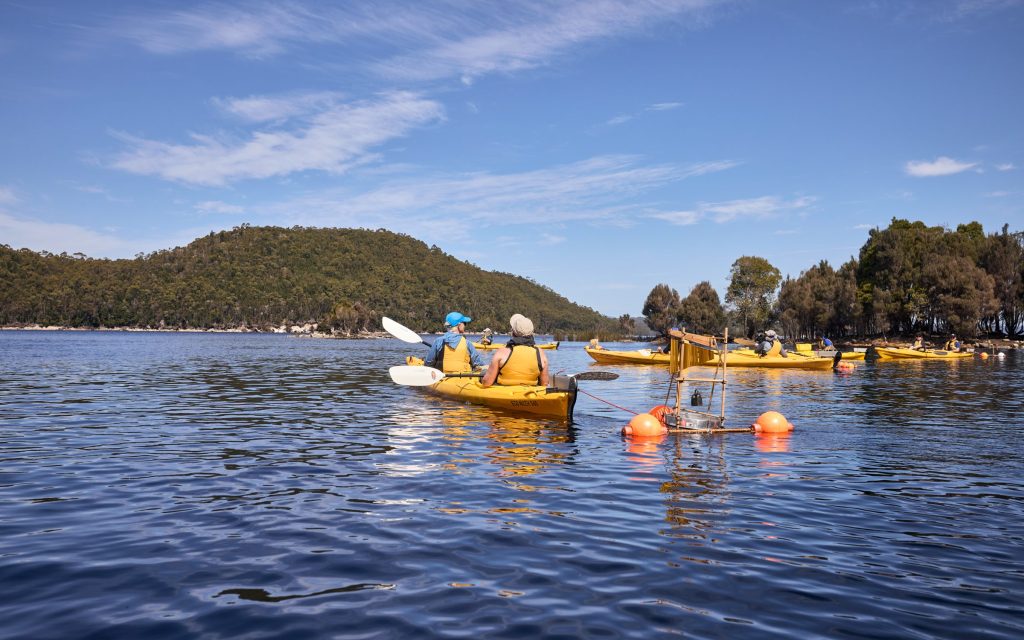Landscape art abounds in Tasmania. The Unconformity did things differently though. Although the vast Tasmanian Wilderness World Heritage Area abuts Queenstown, The Unconformity’s focus was on the mediated landscape, the landscape as industry, as well as the effects of industry on the landscape.
The journey from Hobart to Tasmania’s remote West Coast tells the story of the state’s contradictory relationship with the natural environment. Visitors drive through rich farmland, past massive hydroelectric pipes threaded into deep valleys, around mountains with imposing dolerite crowns, down seemingly endless bends through ancient rainforests, only to be spat out again at the flooded valley that is Lake Burbury – a landscape forever transformed by hydroelectricity.
The final descent through the moonscape hills into Queenstown takes visitors past the shockingly naked Mount Owen that looms over the town. While the hills are slowly revegetating, the landscape remains an uncomfortably beautiful reminder of the devastation humans inflict on the natural environment, but also a hint that this town is not like anywhere else.
Nods to industry were everywhere at the festival, from the old digger parts reused as firepits on Crib Road to the sites used as performance venues. As the sun went down, festivalgoers flocked to an old limestone quarry dominated by Luke Jerram’s Museum of the Moon, which cast an otherworldly glow over the ferns, pond and cliffs. A background chorus of frogs accompanied the ethereal sounds of violinist Natalya Bing.
The dance performance SUB was sited in the Tasmanian Special Timbers Sawmill, the smell of freshly cut timber ever present. Choreographed by Ashleigh Musk, SUB was an aestheticisiation of industry. It was loud, dynamic and, at times, oddly funny. Flexible aluminium ducting was dropped like tentacles onto the dancers, the silver tubing caressing their bodies. The ubiquitous material was transformed into an object quite beautiful and almost anthropomorphic, exaggerating the dynamism as the dance became increasingly violent and the tubing began to shred. The performance ended with the group electrified in movement, sirens blaring and feedback from a dragged microphone emulating crushing rock, the audience’s seating platform vibrating with each beat.

The hills of Queenstown have long been a preoccupation of Raymond Arnold, whose paintings capture the curious faceting and colour of the rocks adjacent to the town’s winding access road. His plein air series, Road to Other, which systematically documents sections of this iconic roadside, were shown at Western Art Space as part of the Art Trail, alongside the brooding lakescapes of Helena Demczuk.
As the recipient of the 2023 West Coast Artist Commission, Arnold’s work also featured in the associated exhibition housed in the old Mount Lyell mining offices. His painting of a tank of acid mine tailings, the surface mirroring the surrounding mountains, captures the strange relationship between the landscape and industry. The hills are not only beautiful, but they also feed the industry that poisons them.
Alicia King’s delicate installation, Aeolian Dust, occupied the former mine manager’s office. Glittering black crystals clung to a wire frame, while magnetised stones spun in mid-air. It was a magical contrast to the staid historical office, which offered a rare glimpse into the once prosperous mining operation seemingly suspended in time with its fax machine, Teledex and glass cabinet library of publications like Labor and Industry or the Journal of the Iron and Steel Institute.
Polly Stanton’s Thresholds also took the public behind the scenes of the now closed Mount Lyell Mine. The Fanta-coloured Queen River and the denuded hills show the mine’s lasting effects, but the underground operation is a mystery to most. In Stanton’s work a split screen video panned over the wounded hills around Mount Lyell, drawing attention to patterns in the ground otherwise unnoticed. Aerial footage showed tendrils of regenerating scrub sprouting in the gullies, and the historic Iron Blow Lookout with its shockingly emerald water ringed by copper stone.
The camera crested a deep open cut mine before plunging underground into an artificial subterranean world lit by bare fluorescent lights. The amplified sound of the mine’s electromagnetic fields made way for the haunting chorus of the Queenstown community choir (dressed in high-vis, of course). The video was extraordinarily powerful, exposing the ugly and the beautiful as they coexist at the site.
While the region’s mining history dominated as a subject at The Unconformity, Dylan Martorell and Lichen Kelp’s participatory Kayak Orchestra was held at the site of another of Tasmania’s landscape-shaping industries, the human-made Lake Burbury. Paddling kayaks adorned with Martorell’s handmade kinetic instruments, the audience played an active role in the soundscape. Nearby birds joined the subtle chorus of percussive sounds until the wind built. Chirps gave way to the creaks of tea trees rubbing against each other and the rustle of wind through the trees. As the kayak drifted, the clunky instrument animated, the metal armature twisting and clumsily scraping across a cymbal. A neighbouring vessel, sporting a rainstick, gave a comforting thunk with each slow rotation. While the ever-present current made it impossible to truly relax, the performance provided a welcome change of pace after three days of frenetic arts activity.
Read: Unconformity rules at this unique celebration of place
Since its beginnings in 2010 (then known as the Queenstown Heritage and Arts Festival), the biennial festival has strengthened with each iteration. Its unapologetic mix of art, history, geology and community makes it truly unique and very much of its place. It’s a festival celebrating a town that refuses to conform.
The Unconformity ran from 19-22 October in Queenstown, lutruwita/Tasmania and is slated to return in 2025.
This review is published under the Amplify Collective, an initiative supported by The Walkley Foundation and made possible through funding from the Meta Australian News Fund.





